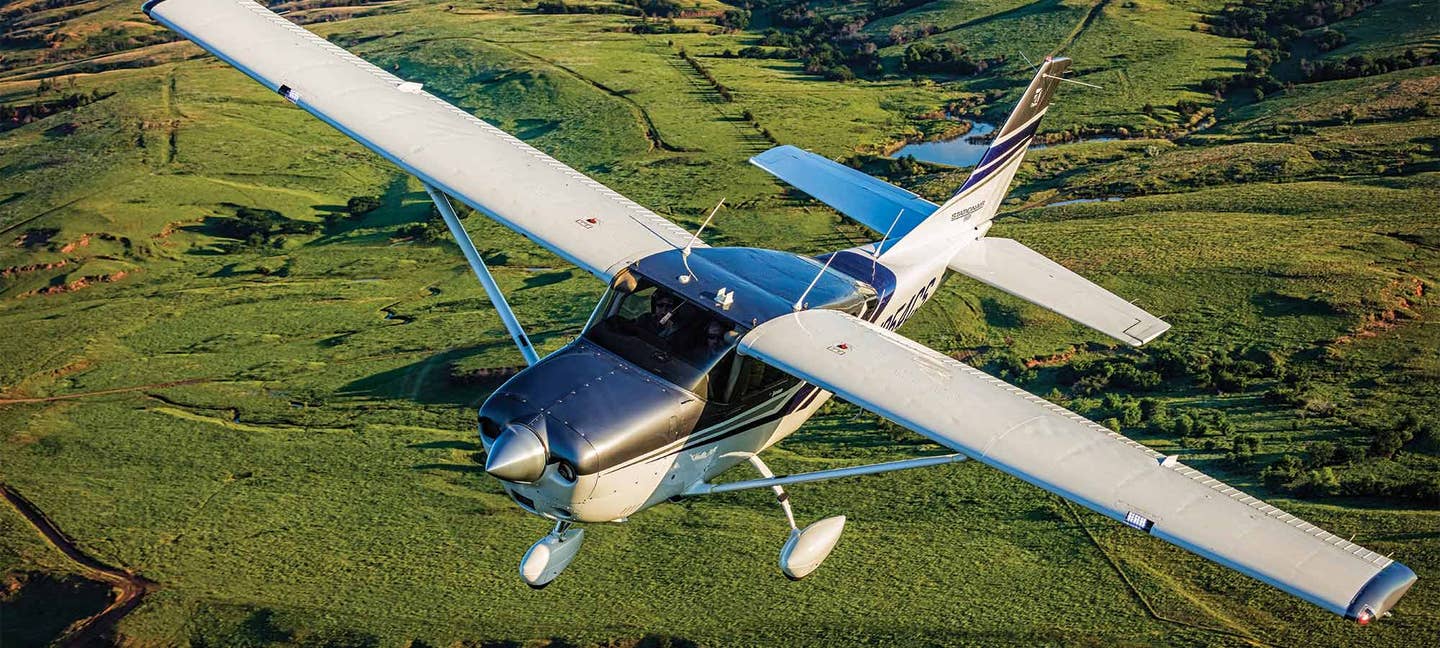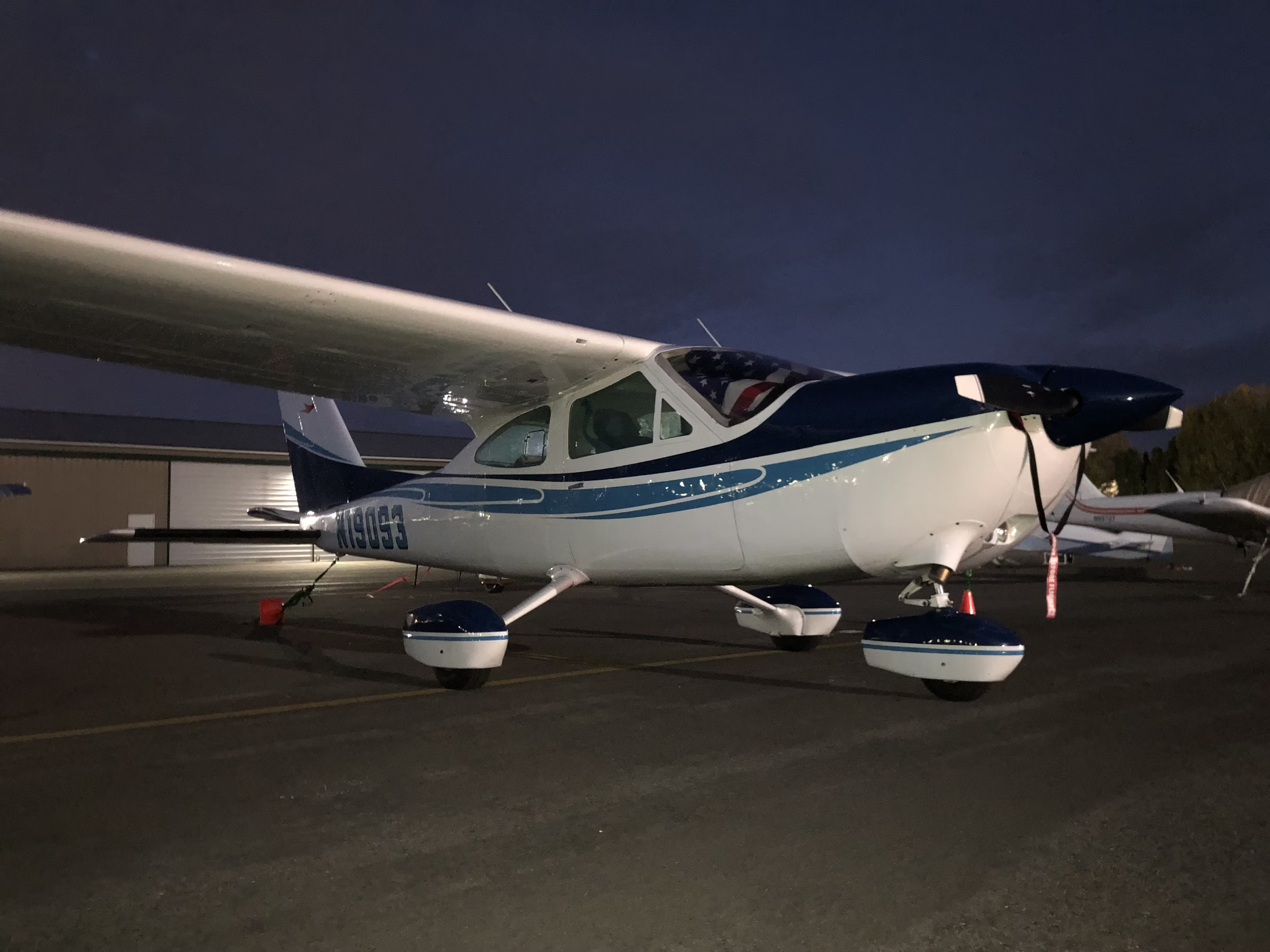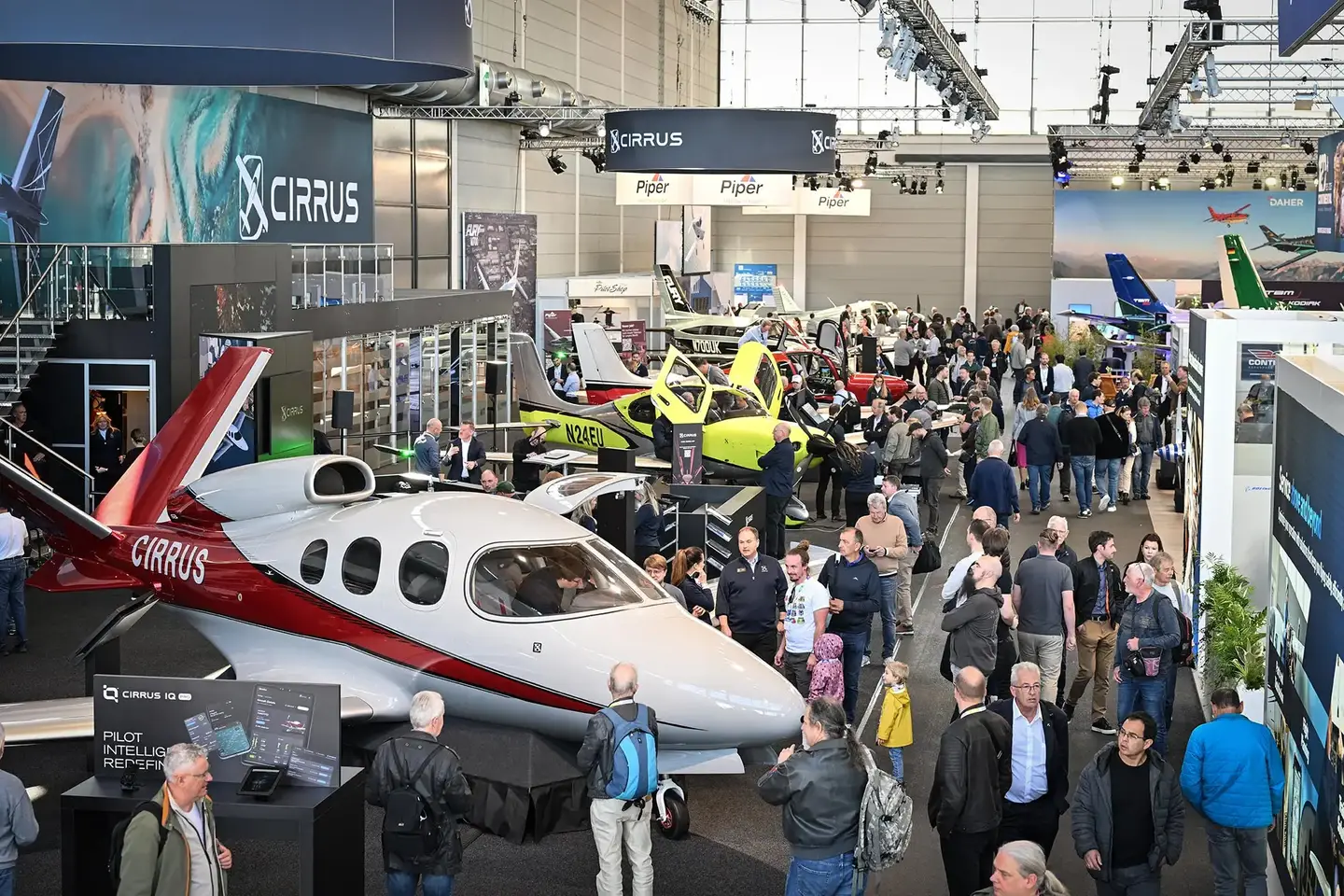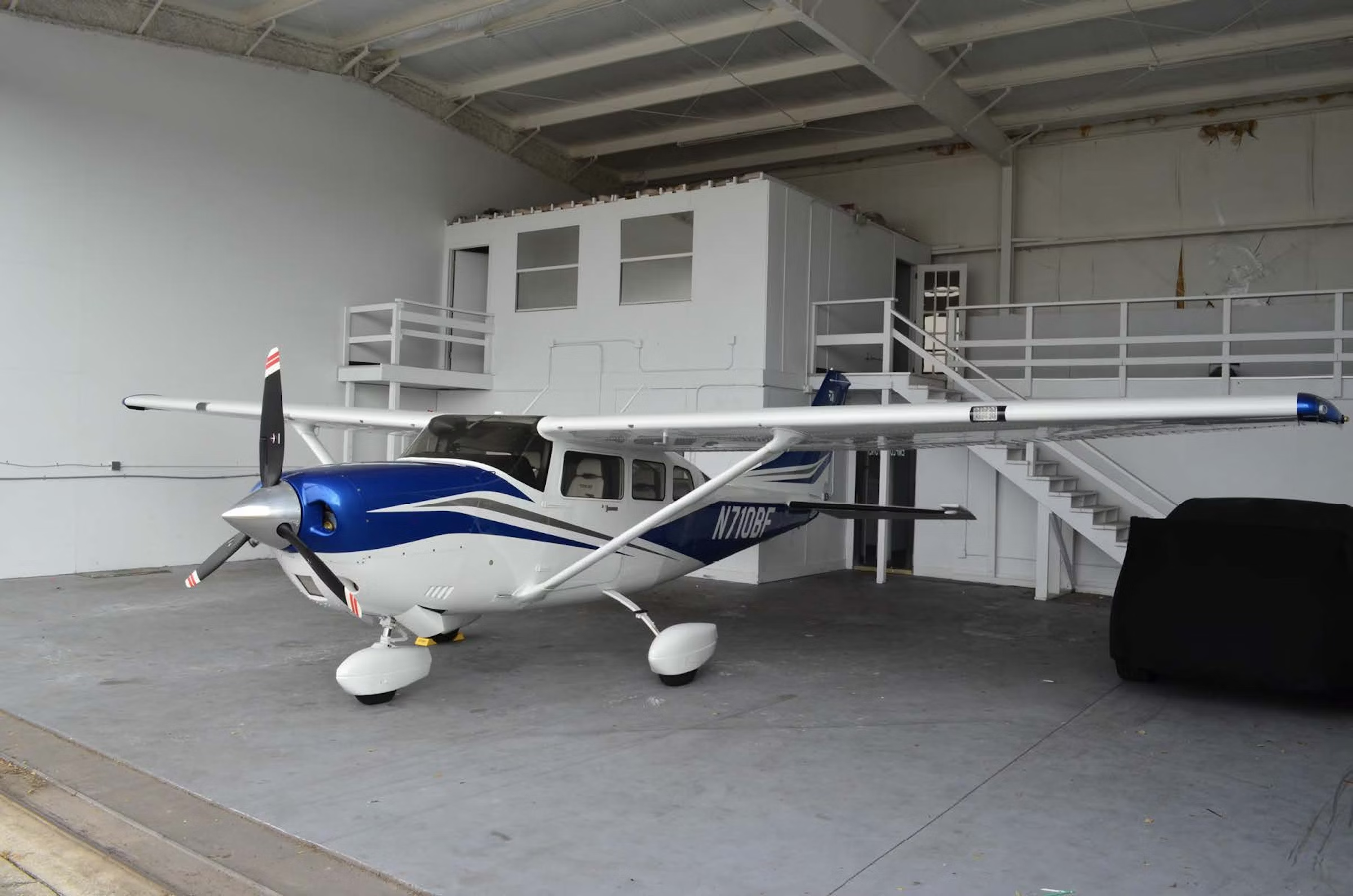
The number of single-engine airplanes capable of hauling a ton of cargo or six people around are pretty limited these days. Cessna’s Caravan is a top choice, but that $2.2 million price tag often puts it well out of reach for many pilots.
When I spent a day with a Cessna Turbo 206 in Wichita, Kansas, recently, I knew only of the six-place airplane’s reputation for hauling cargo and people. Not having flown one before, I assumed it was just a big 182. Not even close, as it turns out.
The 182 uses a 230 hp Lycoming to carry up to four people or fly just over 900 nm at just over 130 knots. At first glance, the Cessna Turbo 206H’s numbers said it wouldn’t even fly 800 nm. But it did have six seats. Then I noticed that the T206, also called the Turbo Stationair, slices through the air at just over 160 knots thanks to a turbocharged 310 hp Lycoming TIO-540 with a big three-bladed McCauley prop hung on the front. Although production rates for the Turbo 206 have slowed over the past decade, Cessna has built more than 1,200 of the SUV-like specialty aircraft since 2000.
The 206 offers pilots plenty of flexibility, like adding fuselage hardware during the manufacturing process, making it easy to add floats or skis later. Cessna added a pair of optional eye hooks to the top of the wing to ease hauling a floatplane-equipped T206 out of the water to hose off the salt. The airplane’s steel spring landing gear can be fitted with tundra tires to make backcountry flying even more fun. Cessna even included mud flaps on the wheel fairings. As a bonus, Garmin’s new G1000 NXi avionics come standard on a new T206.
A first-time 206 operator will do a double take when they realize the airplane’s max load hovers just shy of 1,500 pounds, measured against its 3,789-pound max takeoff weight. Cessna recently increased the 206’s useful load by 180 pounds based on customer demands. That change translates into an airplane with room for six 200-pound people and more than two hours of fuel, perfect for a VFR flight. If two of those passengers happen to be slightly less meaty, there’d be enough fuel for a two-and-a-half-hour IFR trip with reserves based on a 20 gph fuel burn. A closer look at the weight and balance documents show it’s tough to push the center of gravity outside the airplane’s envelope. Saddling up six adults and tossing some weight in the rear cargo area could do it, but just barely. Slinging an optional cargo pod beneath the belly opens the possibility of loading 330 pounds of skis or golf clubs while keeping the CG intact.
Choosing the optional oxygen system provides enough capacity for six people to breathe as the T206 climbs to its 26,000-foot service ceiling. Cessna’s largest piston-powered airplane also adds a door to the right rear of the fuselage to ease entry to the rear cabin, although that extra door comes at the loss of the traditional entryway on the right front of the fuselage. Pilots will be impressed with the airplane’s short-field performance too, thanks to a pair of barn-door-like flaps that can extend to 40 degrees in the full-down position. Inside the cabin, the seats come covered in either real leather or Luxor synthetic material. Cessna says many buyers prefer the synthetic because it’s easier to maintain.
I caught up with N254CS on the Cessna ramp at Wichita and began the walk-around with my demo pilot, Chelsea Carlin. The preflight began inside the cockpit by turning on the master switch to watch the new Garmin NXi avionics come alive in just five seconds. The difference between the original G1000 and the new NXi is immediately noticeable, not simply because of the faster boot-up speed, but thanks to the improved resolution and brilliance of the displays. Missing on the NXi, however, is an electronic version of the pilot operating handbook, as well as any electronic method to calculate weight and balance. A typically equipped T206 is delivered with an autopilot and ADS-B In and Out standard, as well as backup instruments to support the NXi. The system includes VFR charts and the option for electronic checklists. Other T206 options include synthetic vision, terrain awareness, air conditioning, an L3 Stormscope and a SafeFlight angle of attack indicator. Those real leather seats will set you back an additional $4,500.
I set the fuel on the totalizer under the NXi’s engine system page to full, or 87 gallons. Our ramp weight this June afternoon worked out to 3,270 pounds with two people on board, measured against a maximum weight of 3,809 pounds. Like a Cessna 172, the T206’s preferred fuel tank selector position is on “both,” except to cope with an imbalance. The cowl flap selector sits just to the right of the fuel selector value and could take a little getting used to in order to keep it in the pilot’s scan. Our T206’s shoulder harnesses were equipped with airbags.
Outside again, it’s impossible to miss the huge elevator on the 206 that creates solid pitch control. The T206 uses massive ailerons too, with gates at the inboard edge to improve airflow at slow speeds. Since the back doors open near the trailing edge of the right wing, Cessna installed a micro switch to prevent opening the doors with the flaps down, or lowering the flaps when the doors are open to prevent damage to either. In an emergency, however, even with the flaps down, there’s a simple method of opening one door to begin exiting the aircraft.
A nifty safety option makes the LED landing and taxi lights flash automatically whenever the NXi notices nearby air traffic. The walk-around uncovered no less than five under each wing fuel drain and three under the nose. Eight quarts of crankcase oil is perfect to fly, although it can be as low as 6½ and still be airworthy.
Cessna pilots say they feel comfortable operating the T206 out of a 2,000-foot or longer hard-surface runway. A shorter runway is possible but demands a bit more planning, a topic that led Chelsea and me to a discussion of power settings. The T206 likes 39 inches of manifold pressure for takeoff and climb, pulled back to 30 inches for cruise. Cowl flaps are almost always open from takeoff to level off for cruise. The T206 is turbocharged, meaning the system’s turbine essentially stuffs additional air into the engine to make it perform as though it were still at sea level, giving the pilot access to all 310 hp up through about 17,000 feet, one reason for the 206’s impressive climb performance. But this performance comes with a price, the need to be a bit gingerly with the throttle to prevent overboosting the engine. The pilot must also watch the turbine inlet temperature gauge to prevent cooking the engine in the climb, because the internal turbine creates an enormous amount of heat.
Once the big Lycoming was idling, it produced a throaty sound I’m sure made people nearby turn their heads. On the ground, leaning of the mixture is a concern, but usually only when the density altitude exceeds 3,000 feet. At Denver though, where density altitudes can easily approach five figures on a warm day, ground leaning is a must to prevent the engine from quitting when the throttle is pulled back to idle. In the air, the NXi’s lean assist function helps deliver a more efficient fuel flow.
Taxiing the T206 through the rudder pedals delivers the feel of a much larger airplane. The airplane likes 10 degrees of flaps for takeoff, but depending on the runway length, 20 degrees is also a possibility. At sea level and maximum takeoff weight, 20 degrees of flaps yields a ground run of just 1,000 feet, even with an OAT hovering in the mid-80s.
On takeoff roll, I brought the manifold pressure to the full 39 inches. Chelsea told me to rotate at 56 knots and climb at 90 knots. By 40 knots, I could already feel the big single was telling me it was ready to fly. After breaking ground, the T206 quickly accelerated to 90 and I added back-pressure for the climb, retracting the flaps through 200 feet.
The basic physics of flying a piston single came back to me very quickly in the T206, because with 310 hp and that big three-bladed prop, the need for a significant amount of right rudder was apparent as soon as the aircraft began to roll. The T206 is not an airplane for the faint of foot. In fact, rudder movement was needed throughout the flight, contrary to the feet-flat-on-the-floor method of flying that many pilots use these days. Luckily, the T206 comes standard with an adjustable rudder trim.
Holding 90 knots, we were climbing at 1,000 fpm. For me, at least, that spectacular climb rate also made it nearly impossible to see over the nose. I lowered the deck angle and accelerated to 125 knots and found I was still climbing at 600 fpm. Chelsea really liked a slower speed, so I tried 110 knots and found the airplane climbing at 1,400 fpm. When we left Wichita’s airspace a few minutes later, I leveled at 4,500 feet and reduced power to 30 inches and 2,400 rpm, which translated into a 20 gph flow.
Visibility out the T206 windshield is nice considering it’s a high-wing airplane and much above and behind is hidden. The airplane is a bit heavy on the controls, but not overly so. Just enough, I thought, to offer the solid feel I’d like on an airplane in the clouds. I pulled the throttle back to 20 inches to get closer to the 125-knot maneuvering speed to prepare for some 45-degree bank turns. Be ready to use those rudder pedals in the turns.
For traffic pattern practice, Chelsea suggested 18 inches of manifold pressure. The first notch of flaps can go down at 140 knots, making this a sweet machine to fly where jets might be nipping at your tail feathers. The 206 likes 90 to 100 knots in the VFR pattern. Just be ready for a bit of a pitch up when those flaps start to extend. In a typical VFR approach ending in full flaps, we planned to cross the threshold at 70 to 75 knots. I tried a few configuration changes before we tried a landing, and I’m glad I did. While the airplane is easy to fly, dropping that last notch of flaps (40 degrees) feels as if someone has thrown out an anchor. Being low and slow near the ground before dropping that last notch could deliver a face full of trees to an unsuspecting pilot.
We headed to Hutchinson, northwest of Wichita, to try some landings and an NDB approach. The landings went well after the first one when I confirmed Chelsea’s reminder about that last notch of flaps, making me realize I’d probably not add full flaps after breaking out at IFR minimums. With just 20 degrees, the T206 can easily pass over a 50-foot obstacle and stop in under 1,500 feet, so there’s no need to assume every landing demands all the drag. While the nose remained lower on final during a zero-flap approach, the airplane didn’t float all that much before touchdown.
The NDB approach, something I haven’t flown in years, took a bit more planning using the electronics. To legally fly an NDB, this airplane was equipped with an NDB receiver. While it might seem easy to assume a GPS overlay will mark the locator outer marker to Runway 13 at HUT, that NDB receiver is still required. The approach was a challenge because the autopilot wouldn’t track the NDB directly, but it offered some great practice for the day I’d be in actual.
As we headed back to ICT, I planned for a full-flap landing when we ran into the only hiccup of the day, although it had nothing to do with the airplane. The distance from HUT to ICT is about 40 miles, but it took us nearly 35 minutes to fly due to the arrival controller’s vectoring techniques that put us on a wide downwind 20 miles west and southwest of the airport before we persuaded him to let us turn toward the field. Not a terrible inconvenience, of course, but I’ve certainly seen the ICT controllers do a whole lot better.
Once we shut down back at the Cessna ramp, it was easy to see why people love this airplane. It’s both fast and capable of carrying a lot of people and cargo and includes just about every modern convenience. Despite the price difference between a new typically equipped T206, about $665,000, and the 182 I’d first compared it to that runs about $180,000 less with the same equipment, I couldn’t for the life of me understand why anyone wouldn’t choose a T206 over the 182. But of course, I’m not the guy writing the check.

Sign-up for newsletters & special offers!
Get the latest FLYING stories & special offers delivered directly to your inbox






